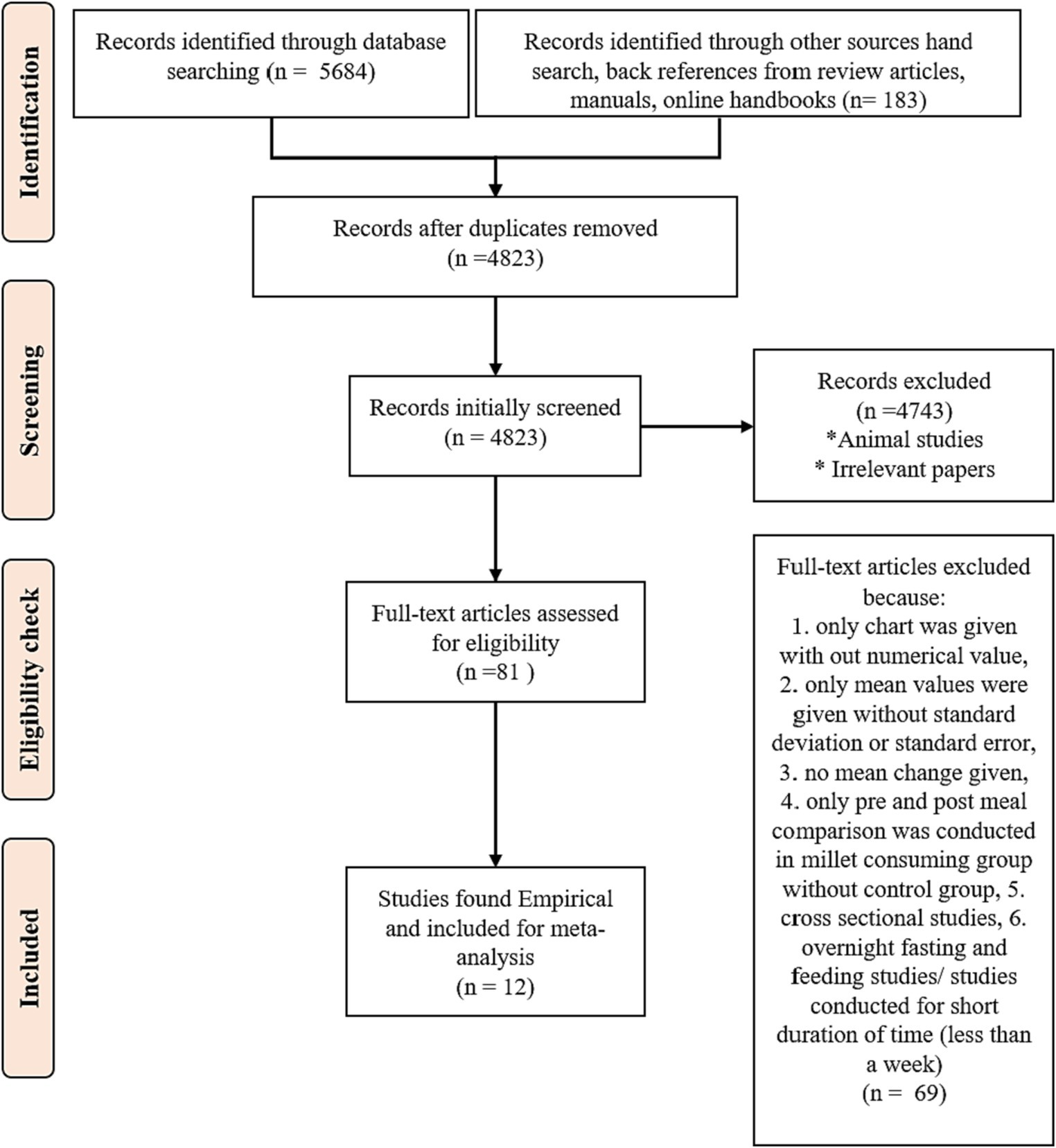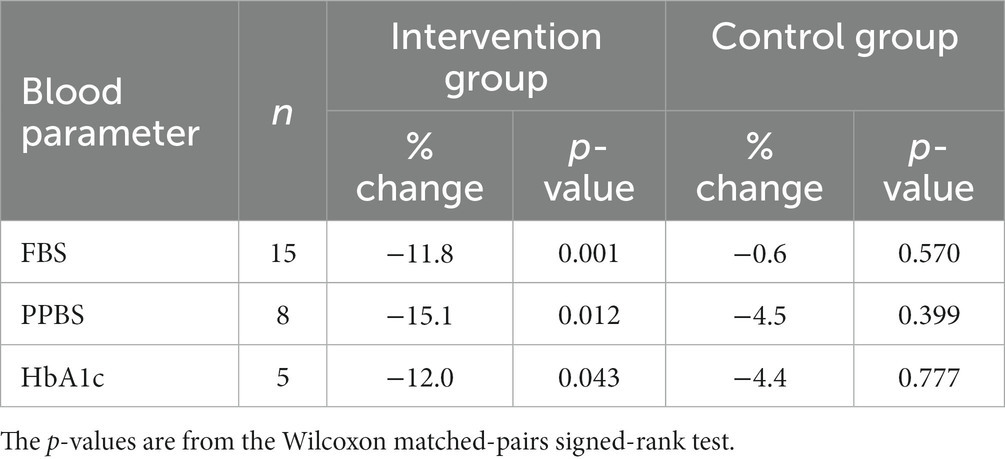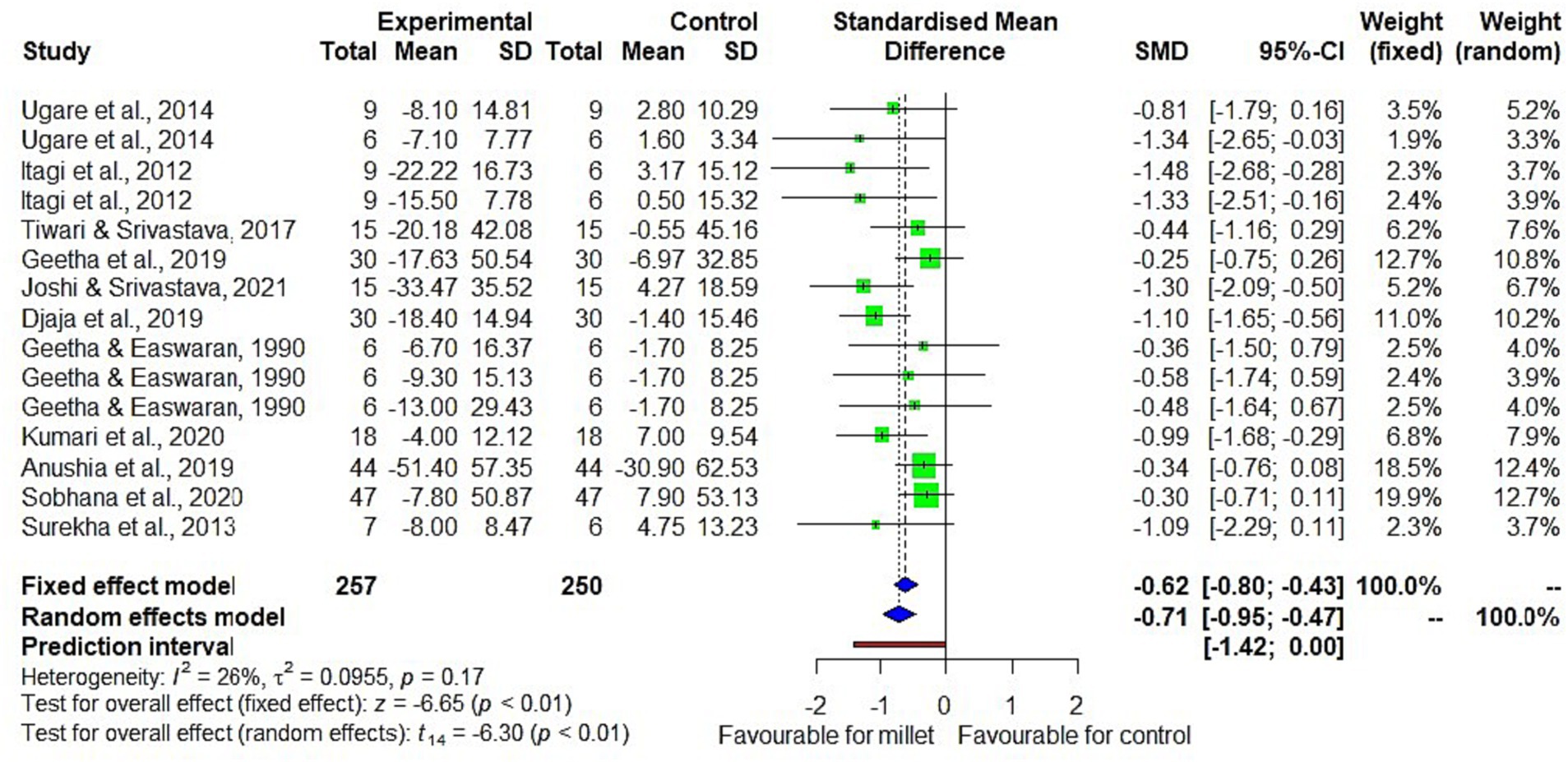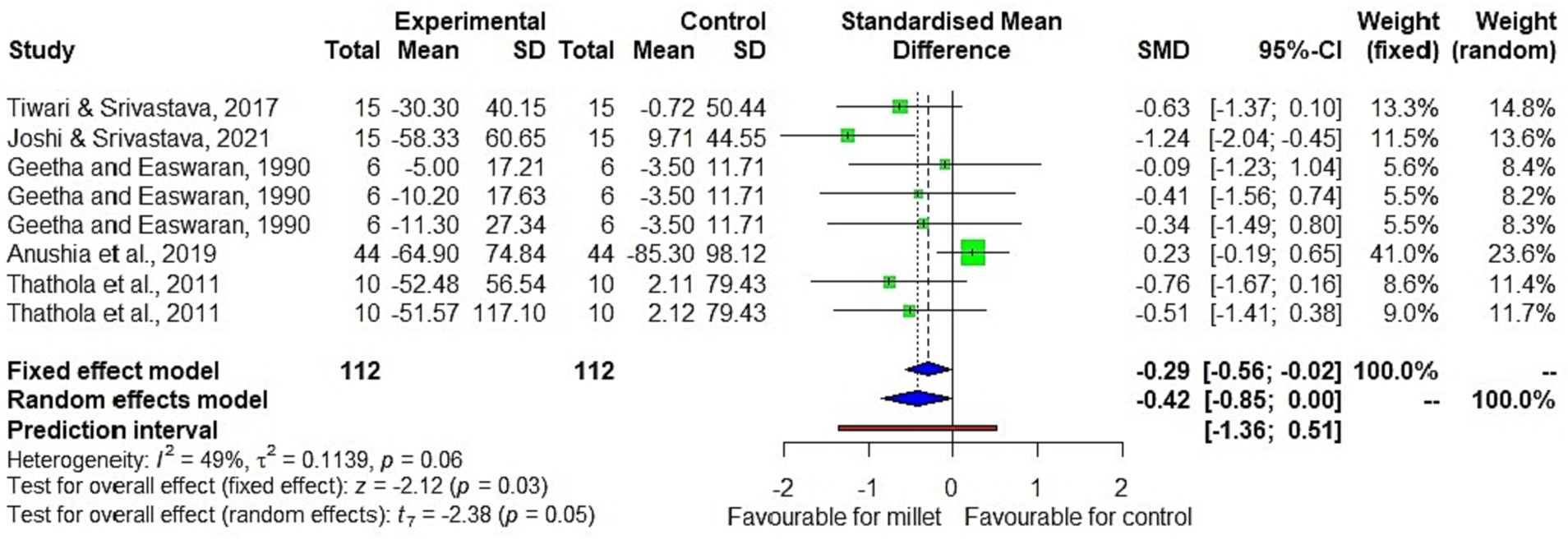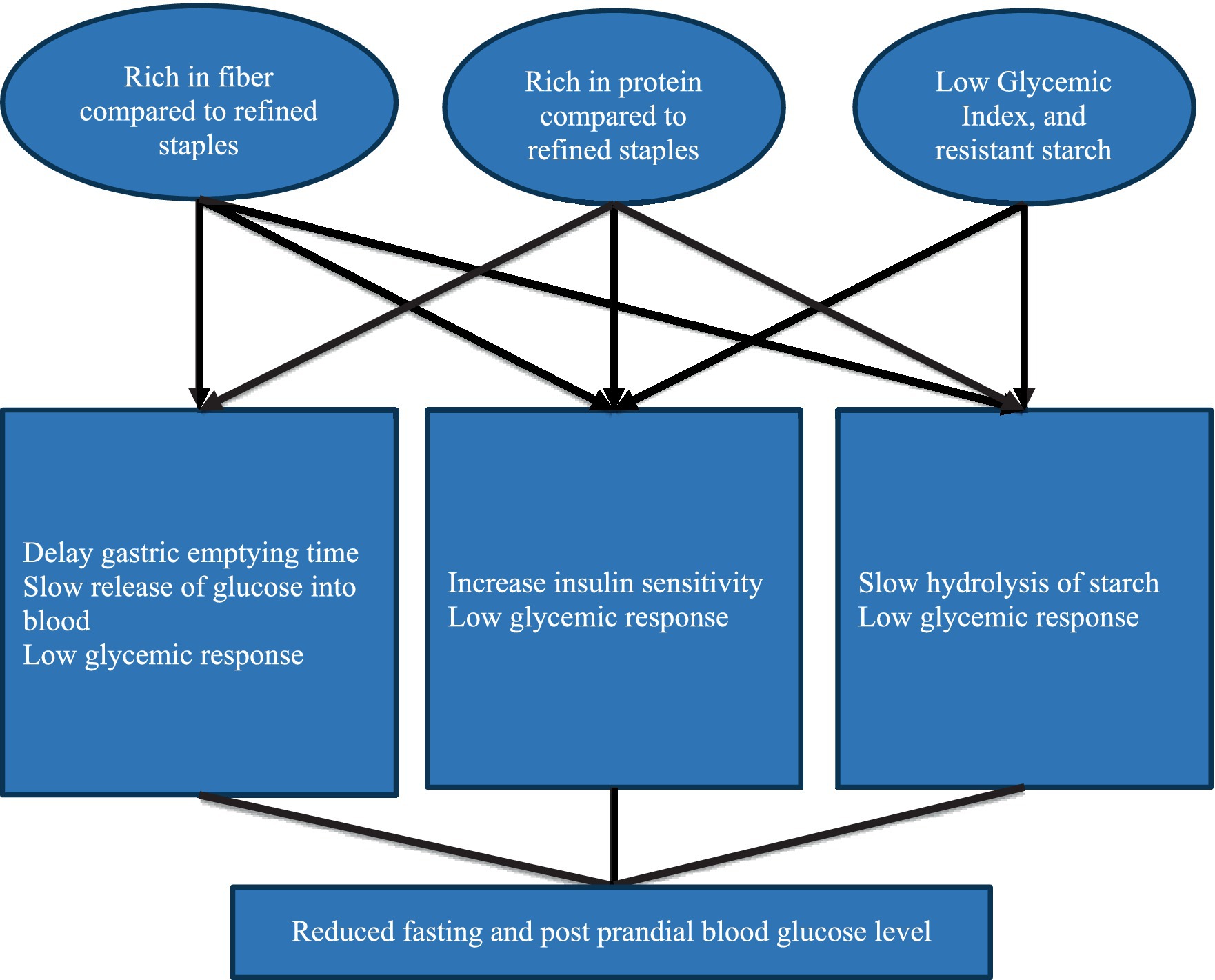- 1Applied Science, University of Lilongwe, Lilongwe, Malawi
- 2Enabling System Transformation, International Crops Research Institute for the Semi-Arid Tropics, Hyderabad, India
- 3Ostrom Center for Advanced Studies in Natural Resources Governance, Asian Institute of Technology, Khlong Luang, Thailand
- 4One Acre Fund, Kigali, Rwanda
- 5Institute for Food, Nutrition and Health, University of Reading, Reading, United Kingdom
- 6National Institute of Nutrition, Hyderabad, India
- 7Food Science and Nutrition, Avinashilingam Institute for Home Science and Higher Education for Women, Coimbatore, India
- 8National Technical Board of Nutrition, Government of India, New Delhi, India
- 9Deputy Director General, Strategy Engagement and Impact, International Rice Research Institute, Los Baños, Philippines
Millets have a low Glycemic Index and are thus expected to help reduce concentration of Fasting and Post-Prandial Blood Sugar (FBS and PPBS) and glycated hemoglobin (HbA1c), which can potentially help the management of type 2 diabetes. This study conducts a systematic review and meta-analysis of the effects of millets consumption on FBS, PPBS, and HbA1c levels in comparison to major staple diets using the difference-in-differences (DID) method, where the effect size was computed on the Standardized Mean Difference scale. Among twelve eligible articles, ten were used in the meta-analysis to assess the effects on FBS levels, while five were used to assess the effects on PPBS levels. The results show significant effects on FBS (p < 0.01) and PPBS (p < 0.05) levels with the effect size of −0.71 and −0.42, respectively. There were 11.8% (p = 0.001) and 15.1% (p = 0.012) reductions in FBS and PPBS level respectively observed in the millet consuming group whereas the comparator group did not have significant reductions in either indicator. On the other hand, the effects on HbA1c levels were insignificant, presumably due to the small sample size where only two studies were undertaken over 90 days, which warrants further research. The findings corroborate the evidence that millets can contribute to managing FBS and PPBS levels better than major staple diets, implying that millets consumption helps reduce the risk of type 2 diabetes.
1 Introduction
The world diabetic population is estimated to increase from 537 million in 2021 to 643 million by 2030, and 783 million by 2045 (IDF, 2022). Three in four diabetic adults live in low- and middle-income countries. Type 2 diabetes accounts for more than 90% of all diabetes. Along with physical exercise, diet plays a key role in managing blood glucose levels. Globally, maize, rice, and wheat are the most consumed crops (Willet et al., 2019), which occupy 70% of the plates. Lack of dietary diversity and junk food consumption add fuel to the increasing obesity and type 2 diabetes cases. While the number of non-communicable diseases is increasing globally, it is high time to reconsider what we eat and ensure adequate nutritional diversity for prevention, diabetic reversal, and sustainable change in dietary habits.
Millets are traditional food crops in Asia and Africa, which contain dense nutrition and have multiple health benefits. The nutritional benefits vary by type and variety of millet and growing conditions. For example, finger millets are high in calcium (Anitha et al., 2021a), and millets in general help in the growth of children (Anitha et al., 2022a). In recent years, there has been scientific evidence of how millets can help in managing type 2 diabetes (Anitha et al., 2021b) and blood lipid profile (Anitha et al., 2022b), while increasing hemoglobin levels (Anitha et al., 2021c). The result in Anitha et al. (2021a) was based only on the changes from the pre-intervention to the post-intervention and not the difference-in-differences (DID) with the involvement of a control group. This study aims to conduct a systematic review and meta-analysis of the effects of millet consumption on Fasting and Post Prandial Blood Sugar (FBS and PPBS) levels and glycated hemoglobin (HbA1c) levels using the DID estimator, where the comparator group consumed other staples.
2 Materials and methods
The meta-analysis was conducted between October 2017 and January 2022 and was retrospectively registered in the research registry with the number “reviewregistry1094” on 28 February 2021. It followed the PRISMA guidelines for a systematic review (Mohar et al., 2009; Page et al., 2021). It included peer-reviewed journal articles published in English language from 1990 to 2021. Key words were used to perform the search using Google Scholar, PubMed, and CABI.
Inclusion criteria: 1. Randomized controlled trials involving millet consuming groups and major staples consuming groups with the outcome measures of FBS, PPBS, and/or HbA1c levels were selected. 2. Studies conducted on adults in any geographical region using any type of millet were considered, and 3. Studies on the long-term effect of millet consumption were included.
Exclusion criteria: Studies conducted for less than a week and studies that did not have enough data (SD, SE, or mean change) for meta-analysis, cross-sectional/observational studies, animal studies, and review articles were excluded.
2.1 Data extraction
The data were extracted from each original eligible article, including the details such as the author and year of the publication, age group and gender of the participants, the number of participants, the country of the study, the duration and method used, the form of food used, the preparation method (cooked/processed) for both the intervention and control groups. The descriptive statistics documented were mean and SD changes in levels of FBS, PPBS, and HbA1c levels. The extracted data were reviewed by two independent reviewers (S.A. and T.W.T.) and entered into a spreadsheet (Harrer et al., 2019).
The DID method incorporates the differences in changes in mean and SD between the intervention and control groups. The changes were basically extracted directly from the paper. Where changes were not directly provided, they were calculated as the difference between the baseline mean and the end-line mean. When the SD of the change was missing, it was computed using the formula as follows:
2.2 GRADE
The GRADE approach was adopted to assess and rate the quality of the selected articles (Ryan and Hill, 2016). The assessment was independently undertaken by two authors of this study (S.A. and T.W.T). When there was any disagreement, another author (R.B) of this paper was involved to make final decisions. The articles were rated for: 1. risk of bias, 2. inconsistency, 3. indirectness, 4. imprecision, and 5. publication bias based on the intensity of bias. Instead of assessing each outcome of the treatment, an overall assessment of each article was conducted.
2.3 Summary measures and result synthesis
Three authors were involved in the process of data verification and meta-analysis (S.A., T.W.T., and R.B.). The changes in mean and SD from the baseline to end-line in each of the two groups were used to calculate the Standardized Mean Difference (SMD) along with the 95% confidence interval (CI) (Isreal and Richter, 2011; Atkinson and Cipriani, 2018; Ahn and Kang, 2019; Balduzzi et al., 2019; Hak et al., 2021; Higgins et al., 2021; Bell et al., 2022). The fixed effect model and the random effect model were adopted to estimate the DID and its statistical significance. While both models were presented in the forest plot chart, the random effect model was mainly used for explanation purposes. The forest plot was obtained using R 4.1.1 (R Core Team, 2021). Moreover, funnel plots were drawn to visually assess the presence of publication bias. The trim and fit model was used for conducting the funnel plot. The changes in FBS, PPBS, and HbA1c in each group were tested using the Wilcoxon matched-pairs signed-rank test.
3 Results
Twelve studies were eligible for the meta-analysis (Geetha and Eswaran, 1990; Thathola et al., 2011; Itagi et al., 2012; Surekha et al., 2013; Ugare et al., 2014; Tiwari and Srivastava., 2017; Anushia et al., 2019; Djaja et al., 2019; Geetha et al., 2019; Kumari et al., 2020; Sobhana et al., 2020; Joshi and Srivastava, 2021; Figure 1). The study characteristics are given in detail in Supplementary Table S1. Table 1 shows percentage changes in the three blood parameters from the baseline to the end-line in each group.
3.1 Fasting blood glucose level
Fifteen studies from ten articles on the effects of millet consumption on FBS levels show the significant negative effects with low heterogeneity (I2 = 26%) with the effect size of −0.71 (p < 0.01) with a 95% CI of −0.95 to −0.47 (Figure 2). The changes in FBS were −11.8% (p = 0.001) in the millet consuming group and insignificant in the comparator group consuming the major staples.
3.2 Post-prandial blood glucose level
Eight studies from five articles on the effects of millet consumption on PPBS levels show the significant negative effects with low heterogeneity (I2 = 49%) with the effect size of −0.42 (p = 0.050) with a 95% CI of −0.85 to 0.00 (Figure 3). The changes in PPBS were −15.1% (p = 0.012) in the intervention group and insignificant in the comparator group.
3.3 HbA1c
Five studies from four articles on the effects of millet consumption on HbA1c levels show the insignificant effects with high heterogeneity (I2 = 87%) (Figure 4). The changes in HbA1c were −12.0% (p = 0.043) in the intervention group and insignificant in the comparator group.
4 Discussion
The GRADE analysis found that none of the included studies explained the sample allocation method in detail nor indicated whether the samples practiced blind testing. However, as millet-based food cannot be blinded due to its unique properties such as appearance, color, and flavor, the rating of the studies was not downgraded on this basis. There was neither indirectness nor inconsistency identified during the GRADE assessment. The forest plot showed low heterogeneity (I2) in blood outcomes, namely 26 and 49% in FBS and PPBS levels, respectively. This may be because the study populations came from the same geographical location (i.e., India) or different types of millet were used in each study (3 studies used finger millet, 3 studies used barnyard millet, 3 studies used mixed or unknown millet, 2 studies used foxtail millet and one study used job tears), or possibly because detailed demographic information with gender disaggregation is not available in most of the studies.
The less symmetric shape of the funnel plot indicated a publication bias from small sample studies, where the studies were scattered in the middle and base of the triangle. Accordingly, the quality of the obtained evidence was rated as moderate. While the existing evidence remains valuable, it is recommended that more studies be conducted with higher rigor across geographical regions with various types of millets, including the most commonly available type for the specific region, to reinforce the substance and credibility of the evidence.
Among the 12 studies, nine reported the exact amount of millet provided to the participants, which was averaged at 86.2 ± 52 g/day and ranged from 20 to 200 g/day. However, there is no information provided on the amount of major staples consumed by the control groups except the studies with clarification of the intake as usual. All studies except two provided more than 70 g of millets per day. The duration of the studies varied from 28 to 180 days. Among the 12 studies, five indicate that the amount of meal typically consumed contained 50 g equivalent of available carbohydrates, one indicates that the meal consumed contained 55 g equivalent of available carbohydrates, and one indicates that the meal had 25 g equivalent of digestible carbohydrates. With the wide variation in the amount of carbohydrates in each meal, the results are most likely a true reflection of the carbohydrate type rather than the amount. The meta-analysis results show significant effects on FBS and PPBS levels. For FBS, the prediction interval was −1.42 to 0.00, indicating a moderate chance of reproducibility of the results if similar studies are conducted again. The decrease in the HbA1c level was not statistically significant, according to the meta-analysis. A possible reason is that only two short-term studies were conducted for 30 and 60 days. The two other studies were conducted for three months. HbA1c is glycose-bound hemoglobin which usually reflects the bound glucose level over the period of three months as the red blood cells are recycled every 80-120 days. Therefore, any meaningful change due to the intervention would require a long-term study of 90 days at the minimum.
The observed change in blood glucose levels is likely due to the high fiber content of the millet compared to the refined rice (Longvah et al., 2017). The fiber content increases the bulk of the food and delays the gastric emptying time and therefore releases the glucose slowly into the blood (Cisse et al., 2018; Hayes et al., 2020). In addition, the type of starch in the millet is resistant starch which also delays starch hydrolysis and facilitates delayed glucose absorption (Hayes et al., 2019). Millets also contain more protein compared to refined rice. The high protein level increases insulin sensitivity and thereby reduces the blood glucose level. These various pathways in reducing blood glucose levels also help manage the blood lipid profile (Anitha et al., 2022b), and reduce the feeling of hunger. The proposed mechanism of action of various component of millet on blood glucose level is provided in Figure 5.
The main limitations of the current study and recommendations are:
1. The inadequate information on the control diets. This lack of specificity regarding the types and amounts of the major staple foods consumed by the control groups hinders a comprehensive understanding of the comparative effects. Providing more details on control diets would enhance the study's robustness and contribute to a more nuanced interpretation of the results.
2. Out of the 12 studies, 11 were conducted in India and one in Sri Lanka, indicating a lack of wider geographical representation. Therefore, it is mostly applicable to the population with similar rice or wheat consumption behavior, limiting the generalizability of the findings only to the populations with similar dietary habits. To strengthen the study's impact and relevance, future research should aim for a more diverse representation of geographical regions.
3. No single study tested the effects of different amounts of millet, different preparation/cooking methods, or different types, polished or unpolished millet or varieties of millet.
4. It is worth noting that a major publication bias arises from the small sample size in the studies, which highlights a weakness in the available literature. Therefore, it is important that future studies include a larger sample size to strengthen the evidence.
5 Conclusion
The meta-analysis indicated that regular consumption of millets helps manage FBS and PPBS levels, thereby reducing the risks of developing type 2 diabetes. This would inform the design of dietary guidelines for populations at risk of diabetes, given the prevalence of diabetes in all regions across the globe. As the Asian population largely consumes diets based on rice and wheat, millet-based interventions can be applied to diversify staples and reduce the risk of diabetes. Governments, development agencies, and dieticians should design programs to diversify staples using millets through awareness-raising, recipe and product development, and marketing campaigns to ensure millet-based diets are accepted in the specific sociocultural environment. Further research is recommended to track the acceptance, usage, and impacts of millet-based diets on diabetes and distinguish the different types of millets, varieties, and cooking forms.
Data availability statement
The original contributions presented in the study are included in the article/Supplementary material, further inquiries can be directed to the corresponding authors.
Author contributions
SA, JK-P, and TWT: conceptualization and investigation. SA, TWT, and DIG: methodology and validation. SA, TWT, and RB: software. SA and TWT: formal analysis and data curation. JK-P: resources. SA, TWT, DIG, JK-P, and AR: writing. DJP, KS, and RKB: writing—review and editing. SA and JK-P: supervision. All authors contributed to the article and approved the submitted version.
Funding
This study was supported by the Odisha Millet Mission, India.
Acknowledgments
The authors appreciate the support provided by the staff members and the library of the Avinashilingam University for Women, Coimbatore, during the data collection.
Conflict of interest
The authors declare that the research was conducted in the absence of any commercial or financial relationships that could be construed as a potential conflict of interest.
Publisher’s note
All claims expressed in this article are solely those of the authors and do not necessarily represent those of their affiliated organizations, or those of the publisher, the editors and the reviewers. Any product that may be evaluated in this article, or claim that may be made by its manufacturer, is not guaranteed or endorsed by the publisher.
Supplementary material
The Supplementary material for this article can be found online at: https://www.frontiersin.org/articles/10.3389/fsufs.2023.1226474/full#supplementary-material
References
Ahn, E., and Kang, H. (2019). Introduction to systematic review and meta-analysis. Korean J. Anaesthesiol. 71, 103–112. doi: 10.4097/kjae.2018.71.2.103
Anitha, S., Givens, D. I., Botha, R., Kane-Potaka, J., Sulaiman, N. L. B., Tsusaka, T. W., et al. (2021a). Calcium from finger millet—a systematic review and meta-analysis on calcium retention, bone resorption, and in vitro bioavailability. Sustainability 13:8677. doi: 10.3390/su13168677
Anitha, S., Givens, D. I., Subramaniam, K., Upadhyay, S., Kane-Potaka, J., Vogtschmidt, Y. D., et al. (2022a). Can feeding a millet-based diet improve the growth of children? A systematic review and meta-analysis. Nutrients 14:225. doi: 10.3390/nu14010225
Anitha, S., Kane-Potaka, J., Botha, R., Givens, D. I., Binti Sulaiman, N. L., Upadhyay, S., et al. (2021c). Millets can have a major impact on improving iron status, haemoglobin level and in reducing iron deficiency anaemia—a systematic review and meta-analysis. Front. Nutr. 8:725529. doi: 10.3389/fnut.2021.725529
Anitha, S., Kane-Potaka, J., Tsusaka, T. W., Botha, R., Rajendran, A., Givens, D. I., et al. (2021b). A systematic review and meta-analysis of the potential of millets and sorghum for managing and preventing diabetes mellitus. Front. Nutr. 8:687428. doi: 10.3389/fnut.2021.687428
Anitha, S., Tsusaka, T. W., Botha, R., Kane-Potaka, J., Givens, I., Rajendran, A., et al. (2022b). Are millets more effective in managing hyperlipidemia and obesity than major cereal staples? A systematic review and meta-analysis. Sustainability 14:6659. doi: 10.3390/su14116659
Anushia, K., Uma Mageshwari, J., Trueman, P., and Viswanathan, V. (2019). The effect of millet supplementation on weight and lipid profile. TAPI J. 13, 1–7.
Atkinson, L. Z., and Cipriani, A. (2018). How to carry out a literature search for a systematic review: a practical guide. BJP Sych Adv. 24, 74–82. doi: 10.1192/bja.2017.3
Balduzzi, S., Rücker, G., and Schwarzer, G. (2019). How to perform a meta-analysis with R: a practical tutorial? Evid Based Ment Health 22, 153–160. doi: 10.1136/ebmental-2019-300117
Bell, A., Fairbrother, M., and Jones, K. (2022). Fixed and random effects models: making an informed choice. Qual. Quant. 53, 1051–1074. doi: 10.1007/s11135-018-0802-x
Cisse, F., Erickson, D. P., Hayes, A. M. R., Opekun, A. R., Nichols, B. L., and Hamaker, B. R. (2018). Traditional Malian solid foods made from sorghum and millet have markedly slower gastric emptying than rice, potato or pasta. Nutrients 10:124. doi: 10.3390/nu10020124
Djaja, N., Permadi, I., Witjaksono, F., Soewondo, P., Abdullah, M., Agustina, R., et al. (2019). The effect of Job’s tears-enriched yoghurt on GLP-1, calprotectin, blood glucose levels and weight of patients with type 2 diabetes mellitus. Med. J. Nutr. Metab. 12, 163–171. doi: 10.3233/MNM-180258
Geetha, C., and Eswaran, P. (1990). Hypoglycaemic effect of millet incorporated breakfast items; on selected non-insulin dependent diabetic patients. Indian J. Nutr. Dietet. 27, 316–320.
Geetha, K., Geetha Yankanchi, M., and Hiremath, N. (2019). Effect of high fibre food mix on lipid profile and body weight in obese subjects. Biomed. Res. 30, 655–658. doi: 10.35841/biomedicalresearch.30-19-257
Hak, T., Van Rhee, H. J., and Suurmond, R. (2021). How to interpret results of meta-analysis; (Version 1.3). Erasmus Rotterdam Institute of Management: Rotterdam. Available at: https://www.erim.eur.nl/research-support/metaessentials/downloads (Accessed April 26, 2021).
Harrer, M., Cuijpers, P., Furukawa, T. A., and Ebert, D. D. (2019). Doing meta-analysis in R: a hands-on guide. Available at: https://bookdown.org/MathiasHarrer/Doing_Meta_Analysis_in_R/.
Hayes, A., Gozzi, F., Diatta, A., Gorissen, T., Swackhamer, C., Bellmann, S., et al. (2020). Some pearl millet-based foods promote satiety or reduce glycaemic response in a crossover trial. Br. J. Nutr. 126, 1168–1178. doi: 10.1017/S0007114520005036
Hayes, A. M. R., Swackhmer, C., Mennah-Govela, Y. A., Martinez, M. M., Diatta, A., Bornhost, G. M., et al. (2019). Pearl millet (Pennisetum glaucum) couscous breaks down faster than wheat couscous in the Human Gastric Simulator, though has slower starch hydrolysis. Food Funct. 11, 111–122. doi: 10.1039/c9fo01461f
Higgins, J. P. T., Thomas, J., Chandler, J., Cumpston, M., Li, T., Page, M. J., et al. (2021). editors. Cochrane Handbook for systematic reviews of interventions version 6.2 (updated February 2021). Cochrane. Available at: www.training.cochrane.org/handbook.
IDF (2022). International diabetes federation - home. Available at: idf.org (Accessed July 2022).
Isreal, H., and Richter, R. P. (2011). A guide to understanding meta-analysis. J. Orthop. Sports Phys. Ther. 41, 496–504. doi: 10.2519/jospt.2011.3333
Itagi, S., Naik, R., Bharati, P., and Sharma, P. (2012). Readymade foxtail millet mix for diabetics. Int. J. Sci. Nat. 3, 47–50.
Joshi, S., and Srivastava, S. (2021). Hypoglycemic and hypolipidemic effect of banyard millet consumption in type 2 diabetic subjects. Int. J. Curr. Microbiol. Appl. Sci. 10, 467–477. doi: 10.20546/ijcmas.2021.1003.062
Kumari, D., Chandrasekara, A., Athukorale, P., and Shahidi, F. (2020). Finger millet porridges subjected to different processing conditions showed low glycemic index and variable efficacy on plasma antioxidant capacity of healthy adults. Food Prod. Process. Nutr. 2:13. doi: 10.1186/s43014-020-00027-9
Longvah, T., Ananthan, R., Bhaskarachary, K., and Venkaiah, K. (2017). Indian food composition table. National Institute of Nutrition, Indian Council of Medical Research: Hyderabad.
Mohar, D., Liberati, A., Tetzlaff, J., and Altman, D. G. (2009). Preferred reporting items for systematic reviews and meta-analysis: the PRISMA statement. Open Med. 3, 123–130. doi: 10.1371/journal.pmed.1000097
Page, M. J., McKenzie, J. E., Bossuyt, P. M., Boutron, I., Hoffmann, T. C., Mulrow, C. D., et al. (2021). The PRISMA 2020 statement: an updated guideline for reporting systematic reviews. BMJ 372:n71. doi: 10.1136/bmj.n71
R Core Team (2021). R: a language and environment for statistical computing. R Foundation for Statistical Computing, Vienna. Available at: https://www.R-project.org/ (Accessed March 1, 2021).
Ryan, R., and Hill, S. (2016). How to GRADE the quality of the evidence? Cochrane consumers and communication group. Version 3.0. Available at: http://cccrg.cochrance.org/author-resources.
Sobhana, P. P., Kandlakunta, B., Nagaraju, R., Thappatla, D., Epparapalli, S., Vemula, S. R., et al. (2020). Human clinical trial to assess the effect of consumption of multigrain Indian bread on glycemic regulation in type 2 diabetic participants. J. Food Biochem. 44:e13465. doi: 10.1111/jfbc.13465
Surekha, N., Chimmad, B. V., and Naik, R. S. (2013). Hypoglycaemic and hypolipidemic efficacy of barnyard millet (Echinochloa frumentacea Link) based health food. Asian J. Home Sci. 8, 383–387.
Thathola, A., Srivastava, S., and Singh, G. (2011). Effect of foxtail millet (Setaria Italica) supplementation on serum glucose, serum lipids and glycosylated haemoglobin in type 2 diabetics. Diabetol. Croat. 40:23.
Tiwari, N., and Srivastava, S. (2017). Effect of finger millet (Eleusine coracana) buns supplementation on serum glucose and serum lipids level in type 2 diabetics. Asian J. Dairy Food Res. 36, 337–340. doi: 10.18805/ajdfr.DR-933
Ugare, R., Chimmad, B., Naik, R., Bharati, P., and Itagi, S. (2014). Glycemic index and significance of barnyard millet (Echinochloa frumentacae) in type II diabetics. J. Food Sci. Technol. 51, 392–395. doi: 10.1007/s13197-011-0516-8
Keywords: type 2 diabetes, millets, fasting blood sugar, post-prandial blood sugar, glycated hemoglobin
Citation: Anitha S, Tsusaka TW, Botha R, Givens DI, Rajendran A, Parasannanavar DJ, Subramaniam K, Bhandari RK and Kane-Potaka J (2024) Impact of regular consumption of millets on fasting and post-prandial blood glucose level: a systematic review and meta-analysis. Front. Sustain. Food Syst. 7:1226474. doi: 10.3389/fsufs.2023.1226474
Edited by:
Rakesh Bhardwaj, Indian Council of Agricultural Research (ICAR), IndiaReviewed by:
Yasinta Muzanila, Sokoine University of Agriculture, TanzaniaMaharishi Tomar, Indian Council of Agricultural Research (ICAR), India
Copyright © 2024 Anitha, Tsusaka, Botha, Givens, Rajendran, Parasannanavar, Subramaniam, Bhandari and Kane-Potaka. This is an open-access article distributed under the terms of the Creative Commons Attribution License (CC BY). The use, distribution or reproduction in other forums is permitted, provided the original author(s) and the copyright owner(s) are credited and that the original publication in this journal is cited, in accordance with accepted academic practice. No use, distribution or reproduction is permitted which does not comply with these terms.
*Correspondence: Seetha Anitha, ZHIuYW5pdGhhc2VldGhhQGdtYWlsLmNvbQ==; Joanna Kane-Potaka, ai5rYW5lLXBvdGFrYUBpcnJpLm9yZw==
 Seetha Anitha
Seetha Anitha Takuji W. Tsusaka
Takuji W. Tsusaka Rosemary Botha
Rosemary Botha D. Ian Givens
D. Ian Givens Ananthan Rajendran
Ananthan Rajendran Devraj J. Parasannanavar
Devraj J. Parasannanavar Kowsalya Subramaniam
Kowsalya Subramaniam Raj Kumar Bhandari
Raj Kumar Bhandari Joanna Kane-Potaka9*
Joanna Kane-Potaka9*